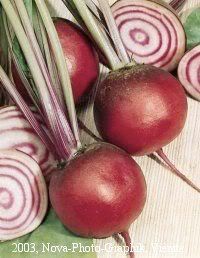
Italian heirloom. Round, exceptionally sweet roots have alternating concentric rings of cherry red and white. Shred fresh for salads. Cooked roots turn a lovely soft pink. Open pollinated. Heirloom. 55 days.
Beta vulgaris: Smooth skin, brightly colored interior and a sweet rich flavor are the traits that rate high in our beet trials.
CULTURE: Beets grow fairly well in almost any soil, but because of their extensive taproot, they prefer deep, moist, rich soil. Prepare the seedbed by working in 2-3 inches of compost or well-rotted manure prior to planting. Beets germinate in soils as cool as 45°F, and the seedlings are frost hardy, but the strongest plants emerge when soil is 55-70°F. In this range, emergence occurs in 5-14 days. At our research farm, we sow beets April through May. Below the seed furrow spread 1 cup of our complete fertilizer per 5-10 row feet. Plant 1 seed per inch, 1/2 inch deep, in rows at least 16 inches apart. Cover the seeds with sifted compost, loose soil, or vermiculite and water evenly. For uniformly sized beets, thin to 3-4 inches when the seedlings are 3-4 inches tall. Thinnings can be used as pot greens or in salads. Keep well watered especially during root development. The 5th and 6th leaf stage is the most critical time for beets to stress. Sudden changes in temperature or moisture will increase zoning (ring formation in the root) and leads to premature bolting. Starting beets indoors is not recommended.
DISEASES: Beets are susceptible to scab, the same disorder that affects potatoes. It causes brown rough spots on the skin. This can be prevented by making sure that your pH level is near neutral (7.0), rotating at least 2 years between potatoes and beets, and keeping your beets adequately watered.
HARVEST: Beets are usually harvested when they reach their desired size for table or canning use. Root size is controlled primarily by spacing and variety, rather than by maturity date. Store at 34°F and 100% relative humidity.
INSECTS/PESTS: Leaf miners cause blistered leaves and are best controlled by picking the infected leaves. Mice, moles, and gophers find beets tasty and sometimes can be discouraged by trapping or underground screens.
----------
PURCHASED: 5g from Nichols Garden Nursery via Garden Fever March '09. $2.25
STARTED SEED:
HARDENED OFF:
TRANSPLANTED IN GARDEN:
DISEASE ISSUES:
INSECT ISSUES:
HARVEST YEILD & DURATION:
OTHER NOTES: Try with this recipe, Chioggia beet and goat cheese tartlet after harvesting. It'll be lovely with fresh leeks from the garden too.
No comments:
Post a Comment